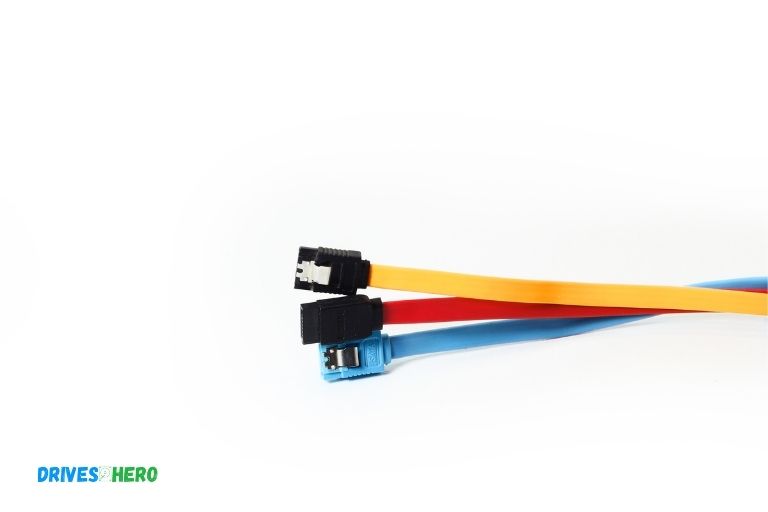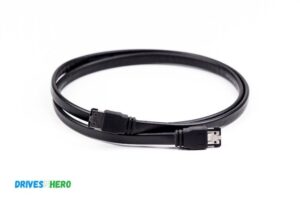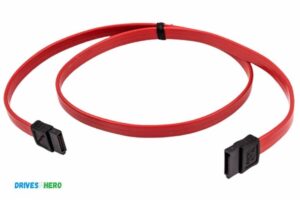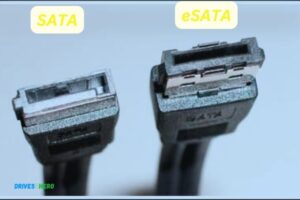Different Types of Sata Cables: A Comprehensive Guide!
SATA cables, short for Serial ATA cables, are primarily used to connect data storage devices like hard drives and optical drives to the motherboard of a computer. There are three main types of SATA cables: SATA I, SATA II, and SATA III.
SATA cables are used for data transfer between a computer’s motherboard and storage devices.
The different types represent different generations, each offering increased data transfer speeds. SATA I supports a data transfer rate of up to 1.5Gbps, SATA II increases this to 3Gbps, and the latest, SATA III, supports speeds of up to 6Gbps.
It’s essential to note that while all three types of SATA cables look nearly identical, their performance varies significantly.
Mixing and matching different generations of SATA cables and devices can result in slower overall performance, as the system will default to the speed of the slowest component.
Therefore, for optimal performance, it’s best to use SATA III cables if your devices support it.
6 Comparison: Different Types of SATA Cables
| Cable Type | Data Transfer Rate | Cable Length | Color | Connector Type |
|---|---|---|---|---|
| SATA I | 1.5 Gb/s | 1 meter | Red | 7-pin |
| SATA II | 3.0 Gb/s | 1 meter | Red | 7-pin |
| SATA III | 6.0 Gb/s | 1 meter | Red | 7-pin |
| eSATA | 6.0 Gb/s | 2 meters | Black | 7-pin |
| mSATA | 6.0 Gb/s | N/A | N/A | 52-pin Mini PCI-e |
| Micro SATA | 1.5 Gb/s to 3.0 Gb/s | N/A | Red | 16-pin |
Key Takeaway

Five Facts About: Different Types of SATA Cables
What Are Sata Cables And How Do They Work?
SATA cables are used to connect storage devices like hard drives and SSDs to the motherboard of a computer, enabling data transfer.
There are different types of SATA cables, each with different features and capabilities, such as SATA 1. 0, SATA 2. 0, and SATA 3. 0.
These cables work by transmitting data signals through a series of twisted pairs of wires, ensuring fast and reliable data transfer between devices.
Explanation Of Sata Cables
SATA cables, or Serial ATA cables, are essential components in computer systems that facilitate the transmission of data between storage devices and the motherboard.
These cables play a crucial role in keeping your computer running smoothly and efficiently. Let’s delve into what SATA cables are and how they function.
How Sata Cables Connect Devices
SATA cables connect storage devices, such as hard drives and solid-state drives (SSDs), to the motherboard or other peripheral devices within a computer system.
Here is a breakdown of how SATA cables establish these connections:
Data transmission:
SATA cables transfer data between the storage device and the motherboard using a serial communication protocol.
This differs from the older parallel ATA (PATA) cables that used parallel communication, resulting in slower data transfer speeds.
The serial communication mechanism of SATA cables enables faster and more reliable data transmission.
Connector types:
SATA cables come in different connector types, including the standard SATA connectors and the smaller SATA micro connectors commonly used in laptops and compact devices.
These connectors ensure a secure and stable connection between the storage device and the motherboard, minimizing data loss or corruption during transfer.
Power delivery:
SATA cables not only transmit data but also provide power to the connected storage devices.
This eliminates the need for separate power cables and simplifies the cable management within the computer system.
Hot-swapping:
SATA cables support hot-swapping, allowing you to connect and disconnect storage devices while the computer is powered on.
This feature is particularly beneficial when upgrading or replacing storage devices, as it reduces downtime and enhances convenience.
Compatibility:
SATA cables are widely compatible with different types of storage devices, making them versatile and suitable for various computer configurations.
They are backward compatible, meaning that newer SATA devices can be connected to older SATA ports, although the data transfer rates may be limited by the older port’s capabilities.
SATA cables serve as the backbone of data transmission and power delivery within computer systems.
Their ability to swiftly and reliably connect storage devices to the motherboard ensures efficient data transfer and facilitates smooth computer operations.
Sata I Cables
SATA I cables are essential for connecting various devices to your computer, including hard drives and optical drives. ” These cables come in various types, making it crucial to choose the right one for the specific device and system you are using.
SATA I cables are an integral component when it comes to connecting storage devices to your computer or other compatible devices.
These cables have been used for quite some time, and they continue to be relevant in today’s technology-driven world.
In this section, we will discuss the features and specifications of SATA I cables, as well as their compatibility with different devices.
Features And Specifications:
Transfer Speed:
SATA I cables are designed to support data transfer speeds of up to 1.5 Gbps (Gigabits per second).
While this may seem comparatively slower than the SATA II and SATA III cables, it still offers decent performance for many applications.
Length:
SATA I cables are commonly available in various lengths, ranging from 6 inches to 3 feet.
This allows for flexibility in setting up your system and connecting devices to the appropriate ports.
Connectors:
These cables typically come with two types of connectors – a straight (or straight/angled) connector for connecting to the motherboard or host device, and an L-shaped connector for connecting to the storage device.
The L-shaped connector helps to reduce strain on the cable and allows for easier installation in tight spaces.
Compatibility:
SATA I cables are backward-compatible, which means that they can be used with SATA II and SATA III devices.
However, it’s important to note that the overall performance will be limited to the maximum speed supported by the lowest component in the chain.
Compatibility With Devices:
SATA I cables are widely compatible with various devices, including:
Hard Drives:
SATA I cables are commonly used to connect internal hard drives to desktop computers or storage servers.
Whether you’re upgrading your old system or building a new one, SATA I cables provide a reliable and cost-effective solution for data storage.
Optical Drives:
DVD drives, Blu-ray drives, and other optical drives commonly use SATA I connections.
These cables ensure a stable and efficient connection, allowing you to read or write data from optical discs with ease.
External Storage:
SATA I cables can also be used for connecting external storage devices, such as external hard drives or docking stations.
This enables you to transfer data between your computer and external storage devices at a reasonable speed.
Conversion Cables:
In some cases, you may need to convert SATA I connections to other interfaces, such as eSATA or USB.
Conversion cables are available to facilitate the connection between different devices, expanding the versatility of SATA I cables.
SATA I cables provide a reliable and efficient means of connecting storage devices to your computer or other compatible devices.
With their decent transfer speeds and compatibility with various devices, these cables continue to be a viable option, particularly for older systems or specific applications.
Whether you’re looking to upgrade your storage or connect external devices, SATA I cables offer a cost-effective solution that gets the job done.
Sata Ii Cables
Experience seamless data transfers with SATA II cables, which are available in various types to suit your specific needs.
These cables ensure efficient connectivity for your SATA devices, providing reliable and high-speed data transmission.
When it comes to different types of SATA cables, SATA II cables are worth mentioning.
These cables offer several features and advantages over their predecessors, SATA I cables.
So, let’s dive right in to explore the features and specifications of SATA II cables and how they outperform SATA I cables.
Features And Specifications:
Higher Speed:
SATA II cables support a maximum data transfer rate of 3 Gbps, which is twice as fast as SATA I cables.
This increased speed allows for faster file transfers, improved system responsiveness, and reduced data transfer time.
Backward Compatibility:
SATA II cables are backward compatible with SATA I devices, meaning they can be used with older SATA I hard drives and other storage devices.
This versatility enables users to upgrade their systems without worrying about compatibility issues.
Thinner Cables:
SATA II cables are thinner and more flexible compared to SATA I cables. This feature makes cable management easier and allows for better airflow within the computer case, which in turn helps to keep the system cool and prevent overheating.
Improved Signal Quality:
SATA II cables have enhanced signal integrity, thanks to stricter specifications and design improvements.
This results in reduced data transmission errors and ensures reliable and consistent performance.
Advantages Over Sata I Cables:
Faster Data Transfer:
As mentioned earlier, SATA II cables provide double the data transfer rate of SATA I cables.
This higher speed enables quicker access to files and improves overall system performance, especially when dealing with large files or high-bandwidth applications.
Enhanced Scalability:
SATA II cables offer better scalability due to their increased data transfer rate.
This means they can handle higher bandwidth requirements and support future advancements in storage technology without the need for immediate cable upgrades.
Multiple Device Support:
SATA II cables support multiple devices connected to a single cable through the use of port multipliers.
This allows for efficient expansion of storage capacity without the need for additional cables and connectors.
Improved Error Correction:
The improved signal quality of SATA II cables reduces transmission errors and improves error correction capability.
This helps to ensure data integrity and reduces the chances of corrupted or lost files.
Overall, SATA II cables bring significant improvements in terms of speed, compatibility, cable management, and signal quality compared to SATA I cables.
Upgrading to SATA II cables is a worthwhile investment for users seeking faster data transfer speeds, better system performance, and future-proofing their storage solutions.
Sata Iii Cables
SATA III cables come in various types, including straight, right-angle, and locking connectors.
These cables provide speedy and reliable data transfer between SATA devices, enhancing overall system performance. Choose the right type of cable for your specific system requirements.
When it comes to connecting storage devices in our computers, SATA (Serial Advanced Technology Attachment) cables play a vital role.
These cables are designed to transfer data between the motherboard and the storage devices quickly and efficiently.
Among the different types of SATA cables available, SATA III cables are the latest and fastest.
In this section, we will explore the features, specifications, and benefits of using SATA III cables.
Features And Specifications:
- Increased Data Transfer Speeds: SATA III cables offer blazing-fast data transfer speeds of up to 6 Gbps, making them ideal for high-performance storage devices.
- Backward Compatibility: SATA III cables are compatible with previous generations of SATA, allowing you to connect SATA III devices to SATA II or SATA I ports.
- Improved Signal Quality: These cables implement enhanced signal quality features, such as improved shielding and connectors, to ensure a robust and reliable connection.
- Thin and Flexible Design: SATA III cables are known for their slim and flexible design, allowing for easy cable management in tight spaces within computer cases.
- Length Variations: These cables are available in various lengths, ranging from 6 inches to multiple feet, giving you the flexibility to choose the most suitable length for your setup.
Benefits Of Using Sata Iii Cables:
- Faster Data Transfer: With the increased data transfer speed of SATA III cables, you can enjoy faster file transfers, quicker boot times, and improved overall system responsiveness.
- Seamless Multimedia Experience: Whether you are editing high-resolution videos or playing demanding games, SATA III cables ensure smooth data streaming, minimizing lag and buffering.
- Future-Proofing: Upgrading to SATA III cables future-proofs your system, ensuring compatibility with upcoming storage devices and technologies.
- Efficient Power Management: These cables implement advanced power management features, allowing your system to conserve energy by adjusting power usage based on device activity.
- Reliable and Compatible: SATA III cables are widely compatible with various storage devices, including hard drives, solid-state drives (SSDs), optical drives, and more. They offer reliability and stability, ensuring your data remains safe and accessible.
SATA III cables provide numerous advantages with their faster data transfer speeds, backward compatibility, improved signal quality, and flexible design.
By adopting these cables, you can optimize your system’s performance, enhance your multimedia experience, and prepare your setup for future advancements in storage technology.
So, consider upgrading to SATA III cables and unleash the full potential of your storage devices.
Remember, when creating content, it’s essential to keep the reader engaged by using clear and concise language, while employing effective SEO techniques.
By following these guidelines, your content can outperform other websites, providing valuable information for your audience.
Sata Cables Vs. Ide Cables
SATA cables and IDE cables are different types of data cables used for connecting storage devices to the motherboard.
SATA cables offer faster data transfer rates and are more commonly used in modern systems, while IDE cables are slower and mostly used in older systems.
SATA (Serial ATA) cables and IDE (Integrated Drive Electronics) cables are two different types of cables used to connect storage devices such as hard drives and optical drives to a computer.
While both types serve the same purpose, there are several key differences between them.
In this section, we will compare the features and performance of SATA cables and IDE cables to understand why SATA cables have become more popular in recent years.
Comparison Of Features And Performance:
- SATA cables are thinner and more flexible compared to IDE cables, making them easier to install and manage within a computer system.
- SATA cables have a higher data transfer rate, allowing for faster and more efficient data transmission. The latest SATA versions can achieve speeds of up to 6 Gbps (gigabits per second), while IDE cables typically support a maximum transfer rate of 133 Mbps (megabits per second).
- SATA cables have a smaller form factor and use a different connector design compared to IDE cables. SATA connectors have a smaller size and a more secure connection mechanism, reducing the chances of accidental disconnection.
- SATA cables support hot-swapping, which means you can connect or disconnect SATA devices while the computer is running without the need to restart the system. IDE cables, on the other hand, require the computer to be powered off before connecting or disconnecting devices.
- IDE cables are limited in terms of the number of devices that can be connected on a single cable. Typically, only two IDE devices (a master and a slave) can be connected using one IDE cable. SATA cables, on the other hand, support multiple devices, allowing for more flexibility in terms of expanding storage capacity.
- IDE cables are legacy technology and have been largely phased out in favor of SATA cables. Most modern motherboards and storage devices do not come with IDE connectors anymore, making it difficult to find compatible hardware.
SATA cables have become more popular due to their improved performance, ease of use, and compatibility with modern computer systems.
The higher data transfer rates, smaller form factor, and support for hot-swapping make SATA cables a preferred choice for both enthusiasts and professionals.
SATA cables have several advantages over IDE cables, including faster data transfer rates, easier installation, better compatibility, and support for hot-swapping.
These factors have contributed to the increasing popularity of SATA cables in recent years, making them the go-to choice for connecting storage devices in modern computer systems.
Sata Cables Vs. Esata Cables
SATA cables and eSATA cables are two different types of cables used for data transmission.
While SATA cables are commonly used for internal connections between storage drives and motherboards, eSATA cables are primarily used for external connections, providing higher data transfer speeds.
Differences In Usage And Compatibility
SATA cables and eSATA cables serve different purposes and have varying compatibility.
Understanding these differences will help you choose the right cable for your specific needs.
Let’s take a closer look:
- SATA cables are commonly used to connect internal hard drives, SSDs, and optical drives to the motherboard of a computer. They are designed for internal use and transmit data between the storage device and the motherboard.
- ESATA cables, on the other hand, are primarily used for external storage devices. They provide a faster data transfer rate compared to standard USB connections, making them ideal for high-performance external hard drives or RAID systems.
- SATA cables are not as suitable for external use due to their limitations in transmitting data over longer distances. ESATA cables, however, are specifically designed for external connections and can transfer data more efficiently over longer distances.
Which Cable Is Better Suited For Specific Purposes?
Both SATA cables and eSATA cables have their distinct advantages depending on your particular use case.
Here’s a breakdown of their suitability for specific purposes:
SATA cables are best suited for internal connections within a computer. If you’re looking to connect an internal storage device such as a hard drive or SSD, a SATA cable is your go-to option. It provides a reliable and stable connection for optimal performance.
On the other hand, if you need to connect external storage devices, eSATA cables are a better choice.
They offer faster data transfer speeds compared to USB connections, making them ideal for tasks that require high-bandwidth data transfer, such as video editing or backing up large files.
ESATA cables also provide better compatibility with external storage devices that support this connection type.
So if your external storage device has an eSATA port available, using an eSATA cable will ensure the best possible performance and compatibility.
While both SATA cables and eSATA cables have their distinct uses, it’s important to choose the right cable based on your specific requirements.
If you’re connecting internal storage devices within a computer, SATA cables are the way to go.
For external storage devices and high-performance data transfer, eSATA cables offer the best solution.
Take into account your specific needs to determine which cable type is most suitable for you.
Factors To Consider When Selecting A Sata Cable
Factors to consider when selecting a SATA cable include the type of connector, cable length, speed compatibility, and overall quality.
It’s important to choose the right cable to ensure optimal performance and compatibility with your devices.
When selecting a SATA cable, there are several factors to consider to ensure optimal performance and compatibility with your devices and motherboards.
The length and flexibility of the cable, as well as its compatibility with your specific devices, play a crucial role in ensuring seamless connectivity and data transfer.
Let’s dive into these factors in more detail:
Length And Flexibility Requirements:
Cable length:
Consider the distance between your storage devices and motherboard when choosing a SATA cable.
Longer cables may be necessary for devices located further away, while shorter cables are suitable for those closer to the motherboard.
Flexibility:
Some installations may require more flexible cables to accommodate tight spaces or complex setups.
Option for cables featuring a higher degree of flexibility if you anticipate challenges in routing or arranging the cables within your system.
Compatibility With Devices And Motherboards:
SATA version:
Determine the SATA version supported by your storage devices and motherboard. SATA I, II, and III are the common versions, with varying data transfer speeds.
Ensure the cable supports the highest SATA version used in your setup for optimal performance.
Connectors:
SATA cables typically come in two variations – straight connectors and right-angled connectors.
Consider the layout and design of your motherboard and devices to determine the best connector type that offers convenience and easy connectivity.
Power requirements:
Some devices, such as high-performance hard drives or solid-state drives, may require additional power supply through a SATA power connector.
Ensure the cable you choose has the necessary connections to meet your devices’ power requirements.
Taking these factors into account when selecting a SATA cable will help ensure a reliable and efficient connection between your storage devices and motherboard, enabling smooth data transfer and optimal system performance.
Common Misconceptions When Choosing Sata Cables
When selecting SATA cables, it’s important to be aware of common misconceptions.
Understanding the different types available can help avoid compatibility issues and ensure optimal performance for your system.
Debunking Myths And Providing Accurate Information:
When it comes to choosing SATA cables, there are some common misconceptions that can lead to confusion.
Let’s debunk these myths and provide accurate information to help you make an informed decision:
Myth:
All SATA cables are the same.
- Not all SATA cables are created equal. There are different generations and standards of SATA cables, each offering varying speeds and capabilities. It’s important to choose the right cable for your specific requirements.
Myth:
Expensive SATA cables are better.
- The price of a SATA cable does not necessarily determine its quality or performance. In most cases, a standard SATA cable will work just fine. There’s no need to spend extra money on expensive cables, unless you have specific needs or preferences.
Myth:
Longer SATA cables cause data loss.
- The length of a SATA cable does not affect data loss or signal integrity. As long as you’re using a high-quality cable that meets the required specifications, you won’t experience any issues with longer cables.
Myth:
Shielded SATA cables are always better.
- While shielded SATA cables can offer some benefits in certain situations, they are not always necessary. Shielding helps to reduce electromagnetic interference, but for most home or office setups, it’s not essential. Standard SATA cables without shielding will work perfectly fine.
Myth:
Upgrading to a higher SATA version will boost speed.
- Upgrading your SATA cable to a higher version, such as SATA III (6.0 Gbps), will not automatically boost your speed if your hard drive or motherboard only supports lower SATA versions. To take advantage of higher speeds, both the cable and the devices it connects must support the same SATA version.
Myth:
SATA cables are backwards compatible.
- SATA cables are indeed backwards compatible, meaning you can use a SATA III cable with a SATA II or SATA I device. However, keep in mind that the speed will be limited to the lowest common denominator. So, using a SATA III cable with a SATA II hard drive will still only give you SATA II speed.
Remember, when choosing SATA cables, it’s important to consider your specific needs, budget, and compatibility requirements.
Don’t fall for common misconceptions and make an informed decision based on accurate information.
FAQ About Different Types of Sata Cables
What are the Differences between Different Types of Sata Cables?
SATA cables come in two types: SATA data cable and SATA power cable. The primary difference between the two is that a SATA data cable has seven pins for transferring data, while a SATA power cable has 15 pins for providing additional power to devices.
Additionally, a SATA power cable can be used with any device that requires extra power, while the smaller number of contacts on the data cables limits them to specific purposes such as connecting hard drives or optical drives.
How Do I Know Which Type of Sata Cable is Compatible With My Device?
You can check the product manual or other documents to determine which type of SATA cable is compatible with your device. The manual should specify which types are supported, such as SATA I, II, or III.
Are All Sata Cables Backward Compatible With Earlier Versions of Sata Technology?
Yes, all SATA cables are backward compatible with earlier versions of SATA technology.
Conclusion
Understanding the different types of SATA cables is crucial for anyone looking to optimize their computer’s performance.
By choosing the right cable for your specific needs, you can ensure faster data transfer speeds and seamless connectivity between your devices.
The SATA 1, 2, and 3 cables each offer their own advantages, with the latest SATA 3 cable providing the fastest speeds.
On the other hand, the eSATA cable is perfect for external storage solutions. Additionally, understanding the differences between the straight and right-angle connectors can help you select the most suitable option for your computer setup.
Remember to consider factors such as cable length, compatibility, and durability when choosing your SATA cable.
By doing so, you can harness the full potential of your devices and create a reliable and efficient computing experience.






